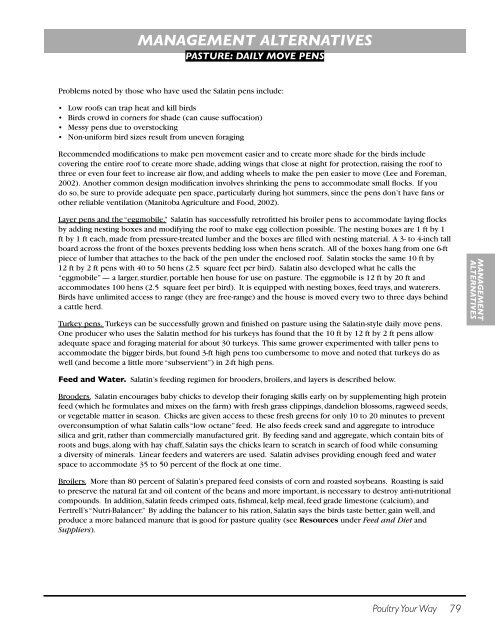Poultry Your Way - Center for Integrated Agricultural Systems ...
Poultry Your Way - Center for Integrated Agricultural Systems ...
Poultry Your Way - Center for Integrated Agricultural Systems ...
Create successful ePaper yourself
Turn your PDF publications into a flip-book with our unique Google optimized e-Paper software.
MANAGEMENT ALTERNATIVES<br />
PASTURE: DAILY MOVE PENS<br />
Problems noted by those who have used the Salatin pens include:<br />
• Low roofs can trap heat and kill birds<br />
• Birds crowd in corners <strong>for</strong> shade (can cause suffocation)<br />
• Messy pens due to overstocking<br />
• Non-uni<strong>for</strong>m bird sizes result from uneven <strong>for</strong>aging<br />
Recommended modifications to make pen movement easier and to create more shade <strong>for</strong> the birds include<br />
covering the entire roof to create more shade, adding wings that close at night <strong>for</strong> protection, raising the roof to<br />
three or even four feet to increase air flow, and adding wheels to make the pen easier to move (Lee and Foreman,<br />
2002). Another common design modification involves shrinking the pens to accommodate small flocks. If you<br />
do so, be sure to provide adequate pen space, particularly during hot summers, since the pens don’t have fans or<br />
other reliable ventilation (Manitoba Agriculture and Food, 2002).<br />
Layer pens and the “eggmobile.” Salatin has successfully retrofitted his broiler pens to accommodate laying flocks<br />
by adding nesting boxes and modifying the roof to make egg collection possible. The nesting boxes are 1 ft by 1<br />
ft by 1 ft each, made from pressure-treated lumber and the boxes are filled with nesting material. A 3- to 4-inch tall<br />
board across the front of the boxes prevents bedding loss when hens scratch. All of the boxes hang from one 6-ft<br />
piece of lumber that attaches to the back of the pen under the enclosed roof. Salatin stocks the same 10 ft by<br />
12 ft by 2 ft pens with 40 to 50 hens (2.5 square feet per bird). Salatin also developed what he calls the<br />
“eggmobile” — a larger, sturdier, portable hen house <strong>for</strong> use on pasture. The eggmobile is 12 ft by 20 ft and<br />
accommodates 100 hens (2.5 square feet per bird). It is equipped with nesting boxes, feed trays, and waterers.<br />
Birds have unlimited access to range (they are free-range) and the house is moved every two to three days behind<br />
a cattle herd.<br />
Turkey pens. Turkeys can be successfully grown and finished on pasture using the Salatin-style daily move pens.<br />
One producer who uses the Salatin method <strong>for</strong> his turkeys has found that the 10 ft by 12 ft by 2 ft pens allow<br />
adequate space and <strong>for</strong>aging material <strong>for</strong> about 30 turkeys. This same grower experimented with taller pens to<br />
accommodate the bigger birds, but found 3-ft high pens too cumbersome to move and noted that turkeys do as<br />
well (and become a little more “subservient”) in 2-ft high pens.<br />
Feed and Water. Salatin’s feeding regimen <strong>for</strong> brooders, broilers, and layers is described below.<br />
Brooders. Salatin encourages baby chicks to develop their <strong>for</strong>aging skills early on by supplementing high protein<br />
feed (which he <strong>for</strong>mulates and mixes on the farm) with fresh grass clippings, dandelion blossoms, ragweed seeds,<br />
or vegetable matter in season. Chicks are given access to these fresh greens <strong>for</strong> only 10 to 20 minutes to prevent<br />
overconsumption of what Salatin calls “low octane” feed. He also feeds creek sand and aggregate to introduce<br />
silica and grit, rather than commercially manufactured grit. By feeding sand and aggregate, which contain bits of<br />
roots and bugs, along with hay chaff, Salatin says the chicks learn to scratch in search of food while consuming<br />
a diversity of minerals. Linear feeders and waterers are used. Salatin advises providing enough feed and water<br />
space to accommodate 35 to 50 percent of the flock at one time.<br />
Broilers. More than 80 percent of Salatin’s prepared feed consists of corn and roasted soybeans. Roasting is said<br />
to preserve the natural fat and oil content of the beans and more important, is necessary to destroy anti-nutritional<br />
compounds. In addition, Salatin feeds crimped oats, fishmeal, kelp meal, feed grade limestone (calcium), and<br />
Fertrell’s “Nutri-Balancer.” By adding the balancer to his ration, Salatin says the birds taste better, gain well, and<br />
produce a more balanced manure that is good <strong>for</strong> pasture quality (see Resources under Feed and Diet and<br />
Suppliers).<br />
<strong>Poultry</strong> <strong>Your</strong> <strong>Way</strong> 79<br />
MANAGEMENT<br />
ALTERNATIVES

















